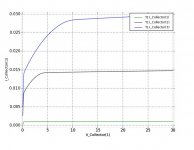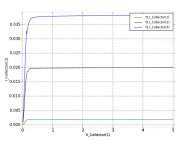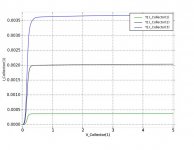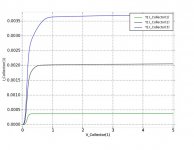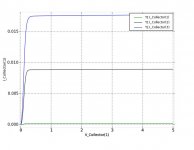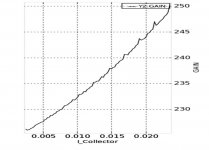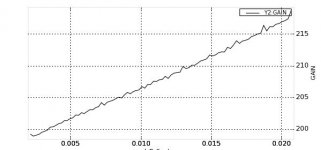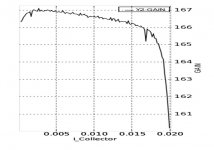Quasi-saturation problems
I am working on a preamp project with + / - 35V rails. The output transistors are KSA3503E and KSA1381E. Near clipping, with a triangle wave, there is crossover distortion and some other visible nasty traces.
After finding this thread, I performed a curve trace of the KSA3503E and the quasi-sat looks rather horrible. Curves are attached.
Then I rummaged in my stash and traced the curves for a BD139 which look much better for quasi sat. Curves are attached.
The preamp deserves a build with the BD139/140.
I am working on a preamp project with + / - 35V rails. The output transistors are KSA3503E and KSA1381E. Near clipping, with a triangle wave, there is crossover distortion and some other visible nasty traces.
After finding this thread, I performed a curve trace of the KSA3503E and the quasi-sat looks rather horrible. Curves are attached.
Then I rummaged in my stash and traced the curves for a BD139 which look much better for quasi sat. Curves are attached.
The preamp deserves a build with the BD139/140.
Attachments
woofertester:
interesting test data. thanks for sharing.
who made the BD139/140 that you tested?
mlloyd1
They are Fairchild BD139-16 parts purchased from Mouser probably 6 years ago.
Looking at the static bag markings, I purchased 25 pcs each of the 139/140.
Beta for the 139 traced is 200.6 at 30V at 10mA. Beta is higher than the typical KSC3503E, but the BD139 cannot be used at high rail voltages. Not a problem for this project as I will use it to drive a low-ish voltage MOSFET OPS.
Quasi-saturation appears to be the compromise you make for low capacitance in the 3503/1381.
The BD139/140 is hard to specify for any DIY project due to the fact that it's completely different depending on which manufacturer you use.
Looks like maybe I got lucky with this batch of BD139/140.
For the KSC3503E/KSA1381E, I suppose that I could add 10V to each rail and stay 10V away from clipping at each rail.
1. I assume you realize that KSC... and 2SC... are ~ the same thing. 2SC3503 are available from other makers.
2. You don't need a 300V transistor for +-35V rails. (70V)
3. BD139 has "better quasi-sat voltages" largely because it's a higher current device, but that generally means slower.
4. IE, look for a 1~4Amp transistor in the same package: My choice would be mje243, mje253, which has real low "on" voltage.
5. mje340/350 are much like the xSC3503/xSA1381, but seem to have better saturation voltages.
2. You don't need a 300V transistor for +-35V rails. (70V)
3. BD139 has "better quasi-sat voltages" largely because it's a higher current device, but that generally means slower.
4. IE, look for a 1~4Amp transistor in the same package: My choice would be mje243, mje253, which has real low "on" voltage.
5. mje340/350 are much like the xSC3503/xSA1381, but seem to have better saturation voltages.
Last edited:
Thanks for the reply. Good points.1. I assume you realize that KSC... and 2SC... are ~ the same thing. 2SC3503 are available from other makers.
2. You don't need a 300V transistor for +-35V rails. (70V)
3. BD139 has "better quasi-sat voltages" largely because it's a higher current device, but that generally means slower.
4. IE, look for a 1~4Amp transistor in the same package: My choice would be mje243, mje253, which has real low "on" voltage.
5. mje340/350 are much like the xSC3503/xSA1381, but seem to have better saturation voltages.
1. From a cursory search, they appear to be obsolete, at least according to Mouser and Digikey. I have enough for my builds.
2. Agreed. Once I am happy with +/- 35V rails operation, I may have a desire to use higher voltage rails. Direct driving Stax headphones is on the list.
3. Slower is ok.
4. 5. I will probably order some of both and run the curves and build up a channel to characterize.
KSC3503/1381 comes from Fairchild, 2SC3503/1381 is NEC (IIRC). They are not necessarily similar in quasi-saturation or other parameters. I've seen some evidence that the Fairchild 3503 has lower base resistance.
KSC/KSA type transistors in commercial integrated amps may also come from Korea Semiconductor (KEC), although I don't think that is true for the 3503/1381. They sell some other BJT copies that might be of interest.
KSC/KSA type transistors in commercial integrated amps may also come from Korea Semiconductor (KEC), although I don't think that is true for the 3503/1381. They sell some other BJT copies that might be of interest.
Last edited:
Sure would like to see vas size devices like BC327-40, BC337-40, N5401 N5551. You know, like 4 to 15pf for npn (4 to 20pf for pnp), fast enough, high hfe, similar hfe at both low and medium current (not drastically less hfe at low current).
Onsemi vs Fairchild BC327-40, BC337-40, are quite different (including speed), and I don't know which has continued after the merger.
For voltage, there's 4 main sizes, office, parlor, great-room (open floor plan living room) and nightclub/hangar; relates to, double the voltage if double the area. So, there is possibility to need 4 different size vas devices, that can be hard to find.
Onsemi vs Fairchild BC327-40, BC337-40, are quite different (including speed), and I don't know which has continued after the merger.
For voltage, there's 4 main sizes, office, parlor, great-room (open floor plan living room) and nightclub/hangar; relates to, double the voltage if double the area. So, there is possibility to need 4 different size vas devices, that can be hard to find.
An hour in the library can often save a month in the laboratory.
If you look at post #16 of this thread you'll see a 2SC3503 (admittedly not a KSC3503) exhibiting loads of quasisaturation.
If you look at post #55 of this thread you'll see a medium-power TO-126 device with none whatsoever. I learned about it by reading a book (AoE 3ed)
If you look at post #16 of this thread you'll see a 2SC3503 (admittedly not a KSC3503) exhibiting loads of quasisaturation.
If you look at post #55 of this thread you'll see a medium-power TO-126 device with none whatsoever. I learned about it by reading a book (AoE 3ed)
An hour in the library can often save a month in the laboratory.
If you look at post #16 of this thread you'll see a 2SC3503 (admittedly not a KSC3503) exhibiting loads of quasisaturation.
If you look at post #55 of this thread you'll see a medium-power TO-126 device with none whatsoever. I learned about it by reading a book (AoE 3ed)
Hi Mark. Thanks for the pointer. Yes the BD437 looks excellent from a quasi sat standpoint. The downside of the BD437 is only 45V Vceo max. ...and... it looks like ST is end-of-life on that part. The big brother, BD441, is obsolete from ST. On Semi, has the BD441 in production.
So, using the 3503E/1381E, I could crank the rails to + / - 45v and possibly get 60v p-p output without the quasi sat problem. I would have to live with the extra heat.
At the moment, My power supplies run out of gas at + / - 35V. Time to buy a new power supply!
The BD437 has an Ft ... wonder what Early voltage is ...
If you feel like exerting yourself, read the previous posts. The numerical value has been measured and written here.
BD139 gain vs KSC3503E gain
The gain of the KSC3503E is flatter compared to the BD139.
It appears for this limited comparison that the good quasi-sat behavior comes at the cost of less good gain flatness.
Which behavior is more important?
For the circuit I am experimenting with, the square wave distortion begins long before the peak voltage comes within 10V of the rails.
I will build a version with the BD139/140 and see if the square wave behavior is improved.
The gain of the KSC3503E is flatter compared to the BD139.
It appears for this limited comparison that the good quasi-sat behavior comes at the cost of less good gain flatness.
Which behavior is more important?
For the circuit I am experimenting with, the square wave distortion begins long before the peak voltage comes within 10V of the rails.
I will build a version with the BD139/140 and see if the square wave behavior is improved.
Attachments
- Home
- Amplifiers
- Solid State
- Looking for a small signal NPN with no Quasi Saturation: MEASURED DATA
